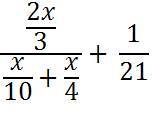Problems vs. Exercises
Inspired by a blogpost by David Cox (@dcox21), I decided to use the same problem and added an extra fraction. Anyone following me for some time would see that I value mathematical thinking and, as David said, this is a good one to show problem-solving skills. I think it’s also a good one to revise, reinforce and connect mathematical skills (or tools as David calls them).
Simplify:
I asked the class what their first thoughts were upon seeing this problem on the board:
- “It looks complicated”
- “It’s hard”
- “It looks like a big problem with lots of little problems”
They were all correct, of course, and I told them so (affirmation is good). I then told them that, in fact, they already have all the skills to solve this problem and they looked at me to as if I’ve gone mad. I suggested that, because it did look complicated, we look at the little problems that make up the big problem to make it easier (note the use of their responses; affirmation is good – oops, said that already).
I then asked what the problem looked like, that is, what’s familiar about the problem.
1. Dividing fractions
2. Adding fractions
3. Algebra – use of pronumerals/letters
Upon revising the above, we added 2 more:
4. Multiplying fractions (division of fractions as multiply by inverse/reciprocal)
5. Order of Operations (fraction bar as a grouping symbol)
And so we set off to solve the problem and they asked for more to practice on, an Exercise as David puts it. This was the desired and expected effect. I used a similar approach when I introduced Decimals to my year 7 class last year (note to self: must share/blog this resource).
I should have also pointed out that this sort of thinking/questioning/problem-solving approach can be applied in real life. Sometimes problems we face in life can seem hard and complex yet often, with chunking (or breaking down into smaller bits), we find that we have the skills/tools to solve them.
